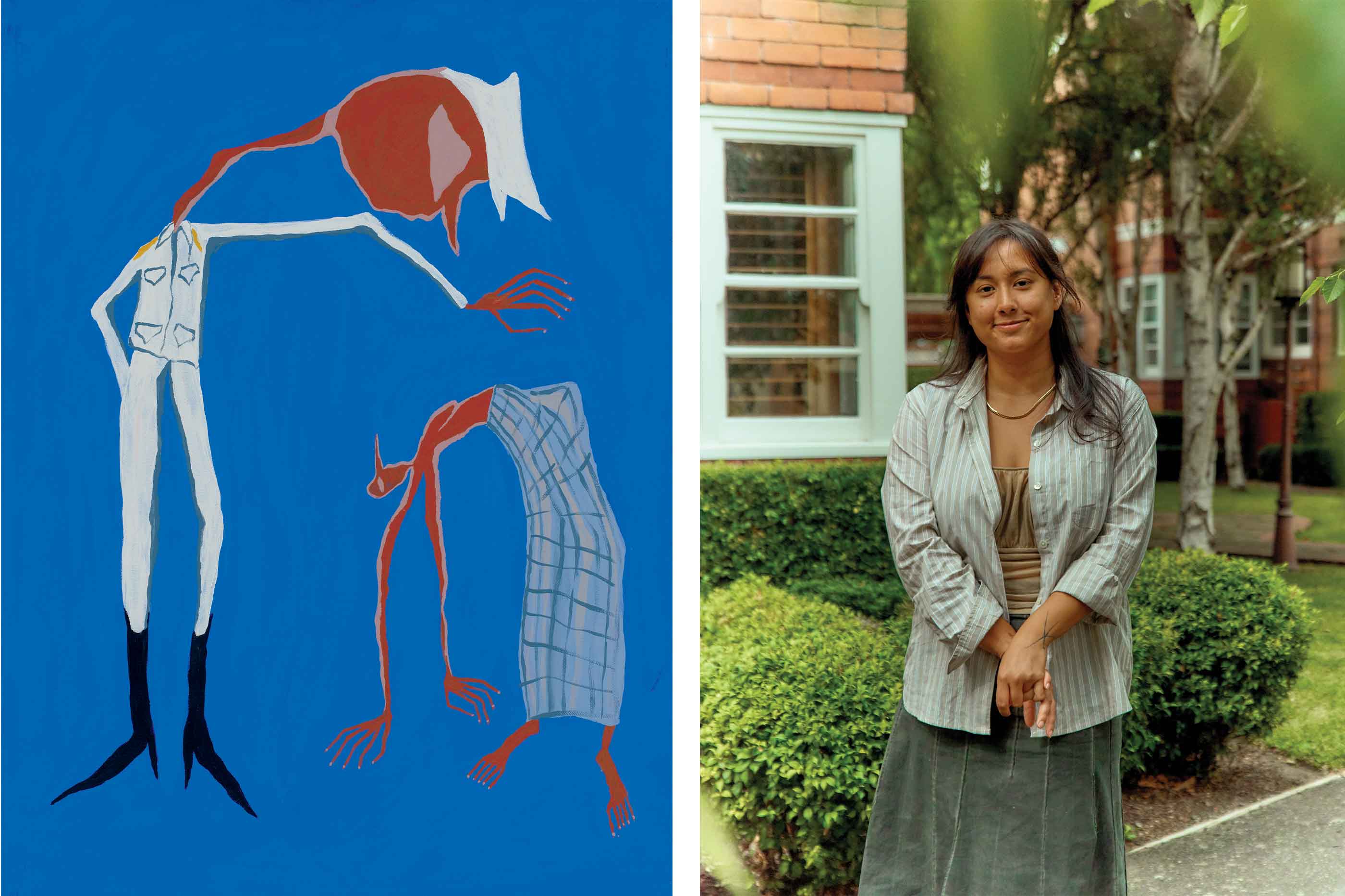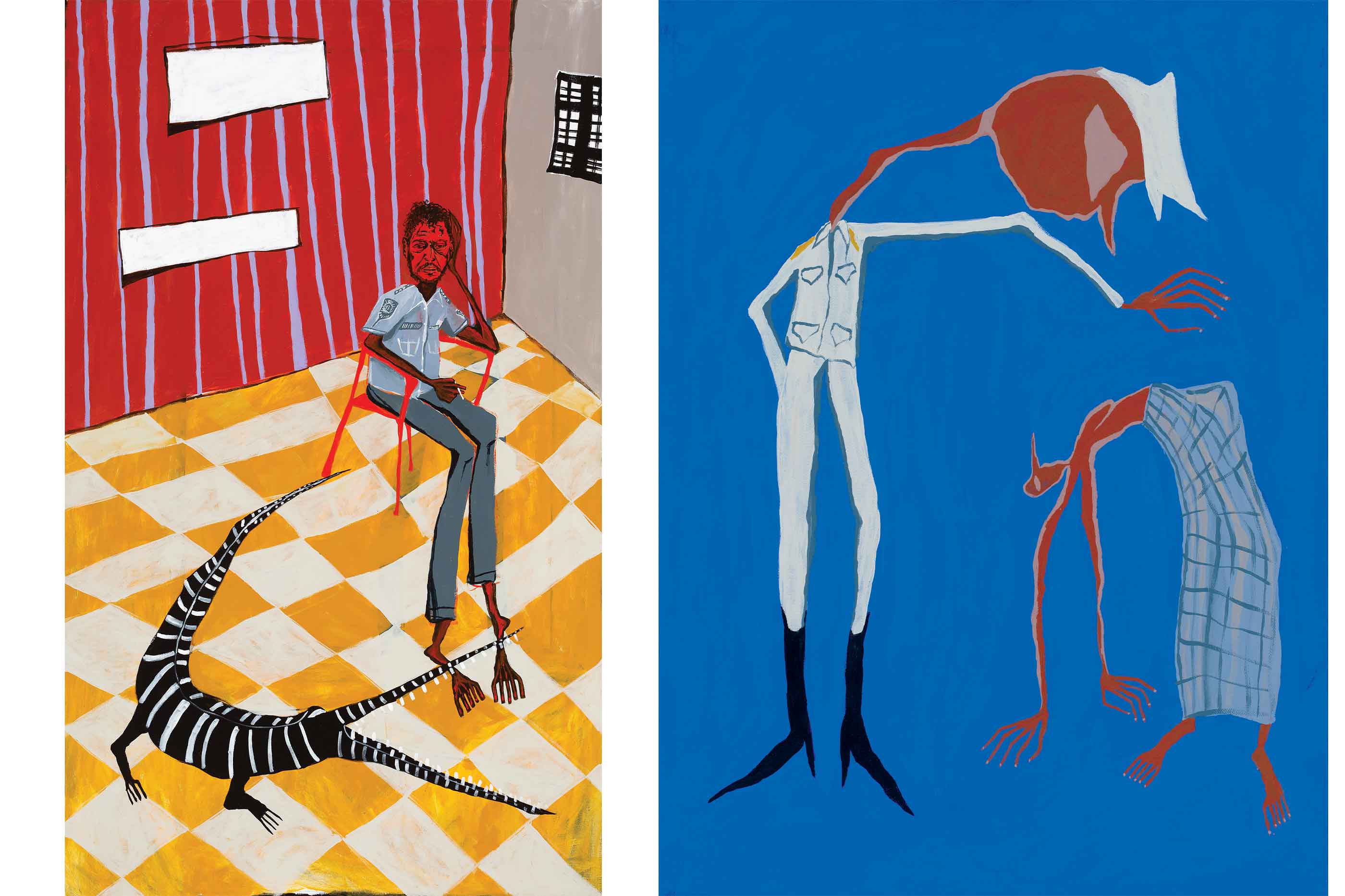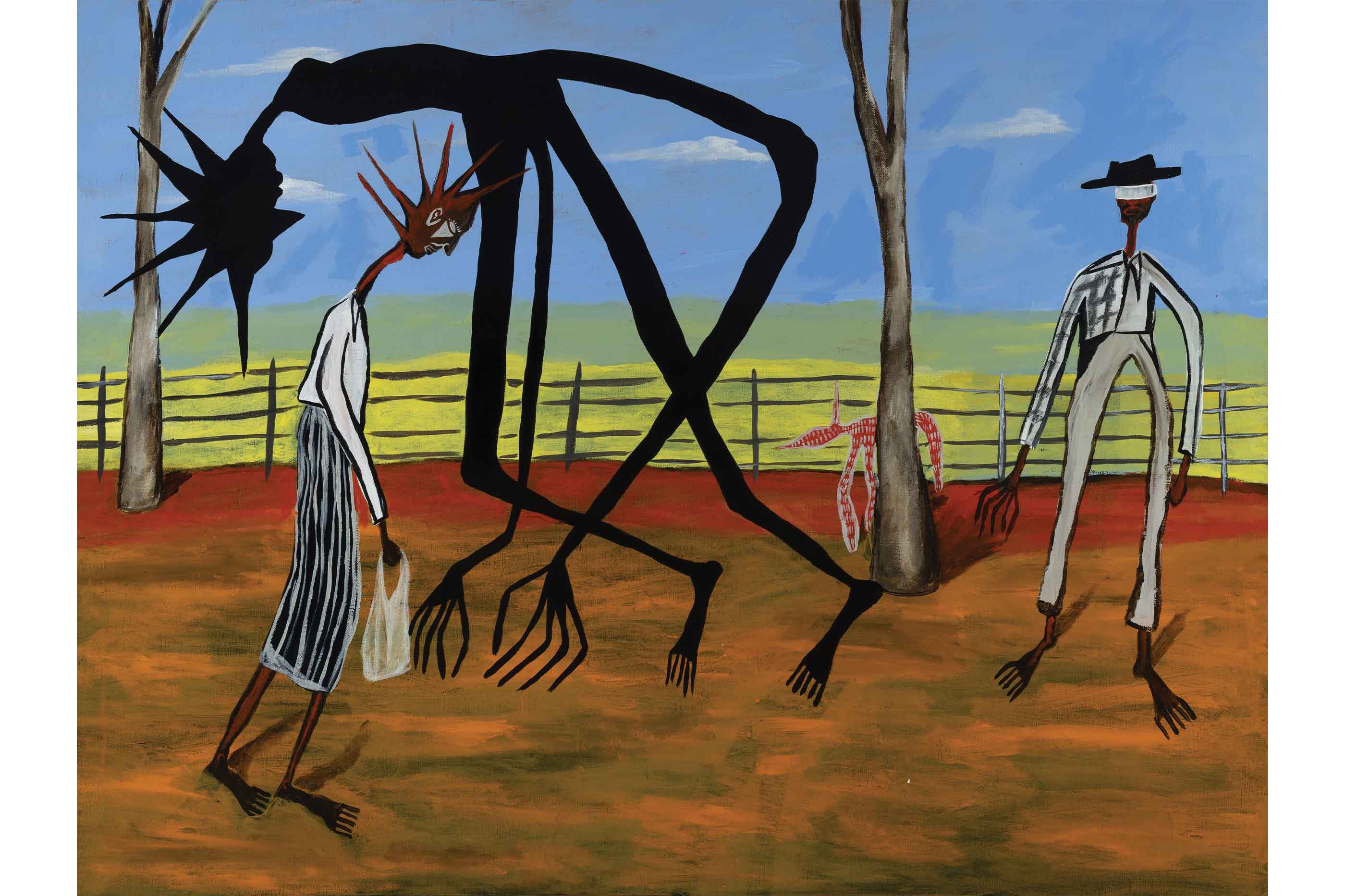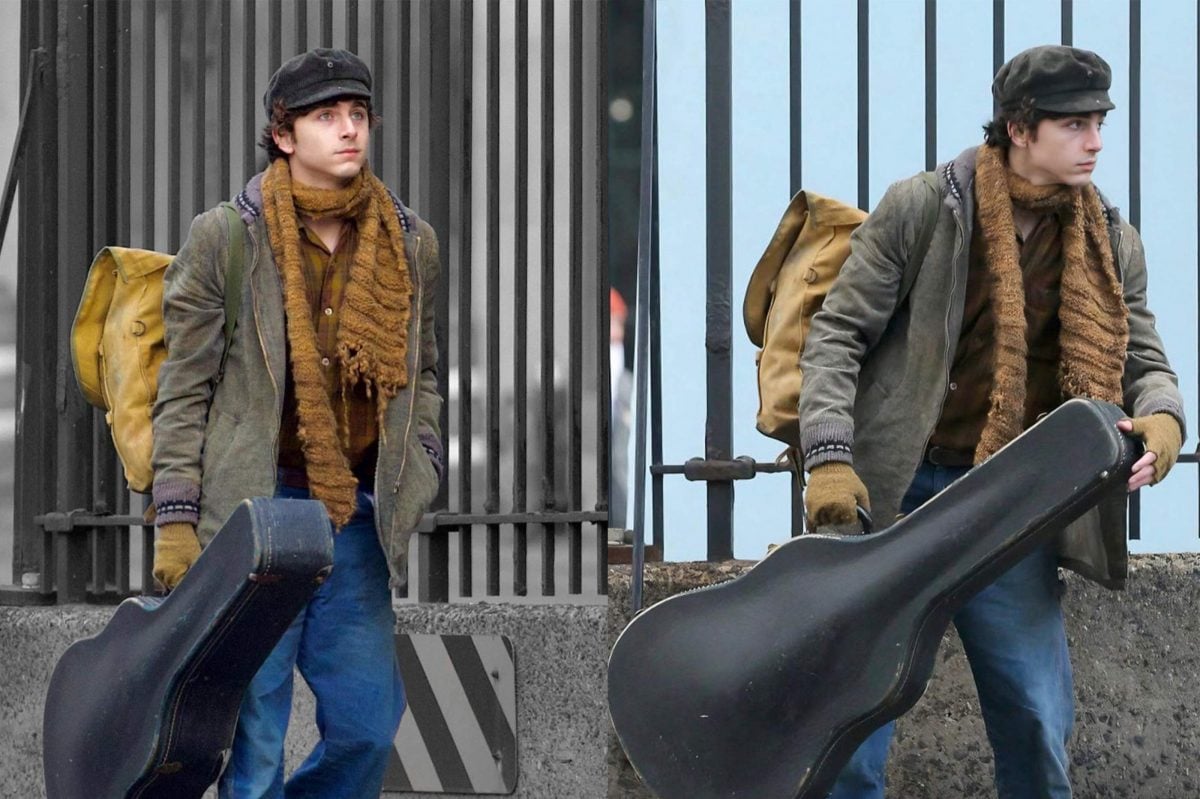
A friendship born out of shared studio space at legendary art incubator Gertrude Contemporary in Melbourne, painter Mia Boe and dancer and choreographer Amrita Hepi became friends and peers. This is a conversation about their immersive art practices, battle with identity – as women, and as artists – and the dilemma of authenticity.
AH: Mia, what I’d love to hear is what is your practice means to you now, and also, how have you gotten here?
MB: It has been a constant battle with myself and my identity. But now, with my art practice, I’m in a very pivotal spot in my career. I’ve gotten a lot of local success early in my career – I’ve only been painting for three years – and I’m getting all these amazing opportunities to do work at the National Gallery of Victoria (NGV) and National Portrait Gallery, and then signing with Sutton Gallery. I actually don’t think I’ve have had much time to work out what I’m getting from art at the moment. Although it’s a really great way to spend my time, with all the other artists at the studio, and going to galleries and being able to support myself from just doing things that I really enjoy, I’m at this point where I just want to move overseas. I want to be totally out of my comfort zone and work out what it is about making art that I want and like.
I grew up in Brisbane, around all these amazing, very political, First Nations artists, like Vernon Ah Kee and Fiona Foley and Gordon Bennett and Richard Bell, etc. And when I first started making art, I wanted to make political black art that looks at history and all this stuff. And that’s still very much true. But I do love artists like yourself, and so many others that don’t have to rely on their own experiences to make stuff. My creative output is very much in the periphery of my experiences, my family and my community. I want to be able to get inspired by external stories and history and music, and relationships. And yeah, just to experiment a bit more really.

LEFT: Mia Boe, Mia and Sidney Nolan (cultural excursionist), 76 × 50 cm, synthetic polymer on linen, 2021. Courtesy of the artist and Sutton Gallery. RIGHT: Mia Boe, In Terrorem, 80 × 60 cm, synthetic polymer on linen, 2022. Courtesy of the artist and Sutton Gallery.
AH: I feel like you’ve raised a really good point whereby a lot of us making art in contemporary art spaces and experimental art spaces, are of course, always influenced by the legacy and the canon. And you also can’t ignore that, in Queensland at the time, you have someone like Joh Bjelke-Peterson (as Premier), and it was fucked, but it also grew this incredible culture map, especially within visual arts and contemporary visual arts. Especially with the artists you just mentioned. But I think I feel the same. I want to, and I will always acknowledge these kinds of foundational narratives that come out of politics. It inextricably rests within me. But this new generation of artists is able to make art that’s informed by the global South, that’s informed by conversations, and we need to let people make art for art’s sake. That’s stuff that I’m into.
But back to your point on identity, we both moved to Melbourne (Naarm) and then we were in Gertrude, and having these conversations with other artists... I had a similar feeling, like when I moved to Naarm, I had a solo show at Gertrude, was commissioned by the National Gallery of Australia, and signed with Anna Schwartz Gallery, and I was like, ‘how do I even begin to conceptualise these things?’ I feel like I inevitably keep on coming back to the same thing, which is the dilemma of authenticity.
MB: It can seem chaotic, but when you’re by yourself in the studio, you realise, ‘I can just slow things down’. It’s okay.

LEFT: PHOTOGRAPHY Adrian Meško. RIGHT: Mia Boe, Riding the Goteik Viaduct, 80 × 60 cm, synthetic polymer on linen, 2021. Courtesy of the artist and Sutton Gallery/
AH: One big thing I’ve been thinking about in my practice of late is how to do things well, and be focussed, but also with a sense of pleasure. There is an idea of hardship of an artist, but on the other hand I know I have choice and autonomy, I want to insert myself into that conversation. In the practice of making, I don’t want it to feel like this Doomsday sentence. I want to be able to be present in it, and collaborative, and generative. I refuse to accept that it’s all a struggle, because that is how you stop doing something, right?
MB: Yeah. And I am such an emotional person. I give so much love and I need so much love. And I need to be able to use that energy in my art. My art can be quite dark and confrontational, but I’m not that dark. I’m not like that. I think I need to find a balance where I can go between the two.
AH: I do find, as dark as you may think your art is, there is this lightness to it. especially with those earlier paintings, the ones with you and Sidney Nolan. You’re kind of putting yourself next to this person, and there’s a cheekiness to it. I often describe my own practice as ‘dead serious, with a wink’. And sometimes when I’m dancing or when I’m making art, and I get stressed, I’m like, ‘oh my god’, ‘this is ridiculous, this is absolutely ridiculous’. But also, there’s nothing else that I would ever want to spend my time doing.
MB: Yeah, I could not work for someone. I could not be told what to do. I do love it. It is this constant paradox. I am obsessed with what I do, but it also stresses me out completely at the same time. But no, I would not trade it at all.

Mia Boe, Cultural Disinheritance, 91 × 122 cm, synthetic polymer on canvas, 2021. Courtesy of the artist and Sutton Gallery.
AH: Let’s talk about moving overseas. Having based on yourself in Naarm now, does it feel like home for a little bit longer? Especially with the amount of movement, or lack of movement, we’ve had in the last couple of years.
MB: I was thinking about this recently when someone asked me like ‘do you like living in Melbourne?’ And because this person wasn’t from Melbourne I said ‘I actually don’t know.’ I couldn’t answer that truthfully. When people ask me how I am, I give a very real answer. I’m not just like, ‘Yeah, fine’. I overshare. So I had to think about this question for a little bit, and honestly, I am happy. I have a lot of great friends here. My boyfriend lives here. My sister lives here. It’s so easy to live in Melbourne.
AH: As an artist, especially. I feel like as an artist there are all these reasons why you do live in Melbourne, but also that world almost swallows you in.
MB: I think about home – I still call Brisbane home. I don’t know if I can see myself going back there anytime soon. But I still think I need to be somewhere tropical and warm.

LEFT: Mia Boe, Tharabo, 120 × 200 cm, synthetic polymer on linen, 2022. Courtesy of the artist and Sutton Gallery. RIGHT: Mia Boe, Suspicion is Proof Enough, 80 × 60 cm, synthetic polymer on linen, 2021. Courtesy of the artist and Sutton Gallery.
AH: Move to Bangkok with me baby!
MB: Seriously, I’d love that. I’ve been thinking about moving somewhere in Asia. Or my dream is to move to Mexico City, just because of all the painters that traveled through there and lived there. And then from there, I’m looking at doing a move next year when Gertrude ends. I just need to do it.
I can get so comfortable, and I can just stay in this l dialogue, but I’m young and I don’t have kids or a mortgage. I just need to do something. I watch artists’ documentaries and look at other artists’ lives and some
of them really lived such cool lives. And I can do that. So, I’m going to make some sort of plan.
AH: To pivot back into what’s coming up for you – you have a show coming up alongside a great artist.
MB: Yeah, so I’m having my first show with the gallery (Sutton Gallery) that I am represented by. And it’s the 10-year anniversary of Gordon Bennett’s death. He was represented, for some time of his life, by Sutton Gallery too, so we’re doing sort of a – it’s not a duo show – it’s like a show alongside one another. The work is going be quite separate. His work will be in the main gallery space at Sutton, and I’ll be in a smaller front gallery.

Mia Boe, The Rainbow Experience, 76 × 102 cm, synthetic polymer on linen, 2021. Courtesy of the artist and Sutton Gallery.
AH: For those that don’t have a historical context of Gordon Bennett, can you talk about what Gordon Bennett means to you?
MB: He had been in my art life since I started looking at art. I first did an assignment on him in high school, and then I looked at him in my research for my university degree. I remember going to his shows in Brisbane, when he was also represented by Milani Gallery in Brisbane. His work is… well he’s like a Picasso. He has done so many things like photography, film, but mostly, I think he’s known for his painting. He was an extremely – well I didn’t know him personally, but from what I can tell about him from his work – he seemed like an extremely thoughtful, emotional, sensitive, even angry person, which I can relate to. The work that they’ve chosen for the show are from his whole career, so it’s like a small survey show of his works. I think he never wanted to be known as, like, ‘a black artist’. He was very against being labelled an Aboriginal artist, and that’s how I relate to him.
I have not made my works yet, and that’s because I cannot decide what I want to do. It’s such an honour to show with him, because he’s been such a huge focus, not just in my art, but relating to my own life being Butchulla and all those things. I think for this show I’m going to do works about my Burmese heritage, and not just that, but the sort of culture in Burma. I’ve only done one exhibition on Burma in the past. My Dad is Burmese. He moved there when he was very young – I think he was five – as a refugee. He has been back a few times, but I didn’t grow up with a strong connection to the place itself. It’s such a complicated country. It was colonised by the British and it is still under this military dictatorship. I think there are a lot of common struggles between Aboriginal Australians and Burmese people, and the different types of colonisation they experience as well. That’s what I’m leaning towards.
I’m excited and I’m nervous, because it’s such an honour to show in the same space with him (Bennett). But really, I’m very excited. He’s one of my idols.
What about yourself? What have you been thinking about and wanting to do?

LEFT: Mia Boe, Going Insein, 90 × 60 cm, synthetic polymer on linen, 2022. Courtesy of the artist and Sutton Gallery. RIGHT: Mia Boe, Fried Fish with Rice, 80 × 60 cm, synthetic polymer on linen, 2022. Courtesy of the artist and Sutton Gallery.
AH: I’ve just been up in Townsville, and I shot a new series of work that sits somewhere in the realm of photography, video, and performance. I made it with my sister, who lives up in Townsville, and we look really similar, we almost look like twins. This will be for a solo show at Anna Schwartz Gallery in August. I have been thinking a lot about the notion of a psychic practice and how you develop psychic powers. I don’t mean this in a woo-woo sense, even though it kind of sounds woo-woo, but like the kind of psychic vision that develops over time between families.
MB: Totally. I feel like with me and the women in my life, especially my Mum, we take on the emotions of our family and partners so intensely. I can see such a difference between my male friends and the male people in my family. We women take it on and turn it into our own experiences, trying to fix problems for everyone. It can feel overwhelming, but also, I can’t not do it at the same time.
AH: It’s like a compulsion.
MB: It is this intense feeling.
AH: I grew up with, predominantly women, and very connected to my aunties on my father’s side. And then on my mother’s side, my mom was one of four girls, and I have five sisters. So, it’s a lot of relating to women. And then it’s also thinking about women, cis-women, hanging out with trans women, who are women, having to tap into that psychic ability to navigate situations. I’m really interested in that. Then on the flip side, I’m interested in where these things, like sexuality and the consumption of it, where it intersects with the public sphere, especially within image-making. Because that’s what you do when you make an exhibition.
Mia Boe’s first exhibition at Sutton Gallery will take place later in 2023, alongside artwork from the Gordon Bennett Estate, curated by Tim Riley Walsh. To experience RUSSH Home in its entirety, issue two will be available on newsstands and online from Thursday 6 July. Find a stockist near you.



